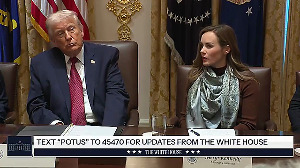One does not quite need to be a rocket scientist to figure out that the RBI has been comfortable with the rupee's decline over the month. The central bank has hardly intervened directly by selling dollars from its huge arsenal of reserves. Nor has it attempted to talk it up with upbeat rhetoric.
The only visible step that to, at least, reduce the momentum of the decline has been the hike in short-term rates in the October credit policy.
But then again, the RBI has been careful not to associate the rate hike too closely with concerns on the currency.
The RBI's apparent indifference is perhaps not difficult to fathom. Much of the rupee's fall has been a spillover of the movements in the euro and yen markets. Both have tumbled against the US dollar over the last couple of months.
Between September and early November the euro shed 4.8 per cent of its value against the dollar and the yen a shade over 6 per cent. If the RBI had intervened and thwarted the rupee's fall against the dollar, our currency would have gained sharply against the other currencies.
The degree of overvaluation, which has been high for most of this year, would have increased. The RBI's official indices, the REERs, show an overvaluation of 8.5-9 per cent in September, relative to the base years of 1993-94 and 2003-04.
The decline of the rupee achieved another objective that I suspect was on the RBI's agenda.
It brought about a correction in the equity markets by spooking institutional investors into lightening their India positions. The fall in local currencies led the sell-off in equities at the end of October not only in India but also in other markets like Thailand and finally put an end to the untrammelled bullishness on domestic stocks.
If the central bank did want to restore sanity in the asset markets, this round of depreciation certainly did the trick.
However, there are no free lunches in economic policy. Every bit of depreciation against the US dollar means that each unit of imports becomes a little dearer.
Given the fact that the bigger fraction of our imports is billed in dollars (particularly for commodities like oil) and that we are importing large amounts of both oil and other things, this could be potentially inflationary. So it's a question of finding the right balance.
One of the factors deciding the way the scale finally tipped has been the direction of commodity prices. Oil prices have been declining since the middle of August and the broader Dow Jones commodity index has mimicked this.
The jury is still out on whether this augurs a more permanent decline in these prices or whether another round of tightening is due. However, it is true that the risk of imported inflation from commodity prices has been much lower in the recent past. This has given the central bank a window of opportunity to let the rupee slip.
Let me get back to the problems of unchecked depreciation -- it often discourages investors from bringing money in. Their fear is that if the local currency continues to depreciate, the possible gains from asset price appreciation would be eaten away through currency losses.
This becomes a circular self-fulfilling syndrome -- foreign investors stay away and this cuts back on dollar supply and the currency depreciates further.
To the investors, this fall seems like an endorsement of the initial expectation and triggers off a free fall in the rupee. In a scenario where liquidity across the globe is getting tighter, a largish drop in foreign inflows could push interest rates above the economy's comfort zone.
The implication of all this is fairly obvious. Unless oil and other commodities were to fall quite a bit more, the central bank cannot entirely ignore the spectre of imported inflation. Nor can it perhaps afford to allow foreign investors to be jittery beyond a point.
Despite its official line that it simply stays in step with flows in the market and occasionally intervenes to iron out excess volatility, it will have to step in to support the market if downward pressures build up.
The current expectation in the market is that the RBI is likely to send some sort of a signal if the rupee crosses the level of 46 to the US dollar. In the slightly longer term, it might even consider a hike in policy rates to iron out the volatility.
A more permanent sense of stability will have to come from cross-currency movements. The dollar's sharp gains against the euro and yen do not mean that some of the structural imbalances that have plagued the American economy have suddenly disappeared. I would not be surprised if some of these concerns returned in the New Year.
Some of the key factors that have driven the dollar up in the recent months such as the large repatriation of profits under the concessional tax regime of the Homeland Investment Act will not be there next year.
As Bernanke takes over from Greenspan as Fed chairman, there would be greater clarity on where US policy rates are going. These could reverse the direction of the dollar against other majors and the rupee.
There is another possible upside for the rupee if China goes in for another round of revaluation against the dollar. Until then, the RBI has to navigate carefully between the Scylla of overvaluation and the Charybdis of rapid depreciation.
The author is chief economist, ABN Amro. The views here are personal.





